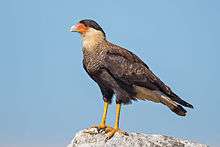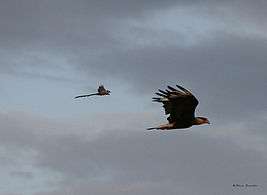Southern crested caracara
The southern crested caracara (Caracara plancus), also known as the southern caracara, carancho or carcará, is a bird of prey in the family Falconidae. As presently defined, the southern crested caracara is restricted to central and southern South America. It formerly included the northern crested caracara (C. cheriway) of the southern United States, Mexico, Central America and northern South America, and the extinct Guadalupe caracara (C. lutosa) as subspecies. Similarly to its relatives, it was formerly placed in the genus Polyborus.
| Southern crested caracara | |
|---|---|
 | |
| Serra da Canastra National Park | |
| Scientific classification | |
| Kingdom: | Animalia |
| Phylum: | Chordata |
| Class: | Aves |
| Order: | Falconiformes |
| Family: | Falconidae |
| Genus: | Caracara |
| Species: | C. plancus |
| Binomial name | |
| Caracara plancus (Miller, 1777) | |
 | |
| Range of the southern crested caracara | |
| Synonyms | |
|
Polyborus plancus | |
Description
It has a total length of 50–65 cm (20–26 in) and a wingspan of 120–132 cm (47–52 in). Weight is 0.9-1.6 kg (2-3.5 lbs), averaging 1,348 g (2.972 lb) in 7 birds from Tierra del Fuego.[2][3] Individuals from the colder southern part of its range average larger than those from tropical regions (as predicted by Bergmann's rule) and are the largest type of caracara. In fact, they are the second largest species of falcon in the world by mean body mass, second only to the gyrfalcon.[3] The cap, belly, thighs, most of the wings and tail-tip are dark brownish, the auriculars, throat and nape are whitish-buff, and the chest, neck, mantle, back, uppertail-coverts, crissum (the undertail coverts surrounding the cloaca) and basal part of the tail are whitish-buff barred dark brownish. In flight, the outer primaries show a large conspicuous whitish-buff patch ('window'), as in several other species of caracaras. The legs are yellow and the bare facial skin and cere are deep yellow to reddish-orange. Juveniles resemble adults, but are paler, with streaking on the chest, neck and back, grey legs, and whitish, later pinkish-purple, facial skin and cere.
It can be separated from the similar northern caracara by its more extensive barring on the chest, brownish and often lightly mottled/barred scapulars (all blackish in northern), and pale lower back with dark barring (uniform blackish in northern). Individuals showing intermediate features are known from the small area of contact in north-central Brazil, but intergradation between the two species is generally limited.
 Eggs MHNT
Eggs MHNT- juvenile
- young adult
- adult
Behavior
A bold, opportunistic raptor, the southern crested caracara is often seen walking around on the ground looking for food. It mainly feeds on carcasses of dead animals, but will steal food from other raptors, raid bird nests, and take live prey if the possibility arises (mostly insects or other small prey, but at least up to the size of a snowy egret), it may also eat fruit. It is dominant over the black and turkey vulture at carcasses. It is typically solitary, but several individuals may gather at a large food source (e.g. dumps). Breeding takes place in the austral spring/summer in the southern part of its range, but timing is less strict in warmer regions. The nest is a large open structure, typically placed on the top of a tree or palm, but sometimes on the ground. Average clutch size is two eggs.
_2.jpg) young adult, showing the distinctive light 'windows' in the wings
young adult, showing the distinctive light 'windows' in the wings- adult
 Being mobbed by a fork-tailed flycatcher
Being mobbed by a fork-tailed flycatcher
Distribution and habitat
The southern crested caracara occurs from Tierra del Fuego in southernmost South America north to the Amazon River region and southern Peru. An isolated population occurs on the Falkland Islands. It avoids the Andean highlands and dense humid forest, such as the Amazon rainforest, where it is largely restricted to relatively open sections along major rivers. Otherwise, it occurs in virtually any open or semi-open habitat and is often found near humans.
Status
Throughout most of its range, it is common to very common. It is likely to benefit from the widespread deforestation in tropical South America. It is therefore considered to be of Least Concern by BirdLife International.
References
- BirdLife International (2012). "Caracara plancus". IUCN Red List of Threatened Species. 2012. Retrieved 26 November 2013.CS1 maint: ref=harv (link)
- Info about the southern caracara at Zootierliste.de
- CRC Handbook of Avian Body Masses, 2nd Edition by John B. Dunning Jr. (Editor). CRC Press (2008), ISBN 978-1-4200-6444-5.
- Dove, C. & R. Banks. 1999. A Taxonomic study of Crested Caracaras (Falconidae). Wilson Bull. 111(3): 330–339. Available online (PDF)
- Ferguson-Lees, J., D. Christie, P. Burton, K. Franklin & D. Mead (2001). Raptors of the World. Christopher Helm. ISBN 0-7136-8026-1
- Restall, R., C. Rodner, & M. Lentino (2006). Birds of Northern South America. Vol. 1 & 2. Helm, London. ISBN 0-7136-7242-0 (vol. 1); ISBN 0-7136-7243-9 (vol. 2)
- Schulenberg, T., D. Stotz, D. Lane, J. O'Neill, & T. Parker III (2007). Birds of Peru. Helm, London. ISBN 978-0-7136-8673-9
External links
| Wikimedia Commons has media related to Caracara plancus. |
- Photos and text - arthurgrosset.com
- Photos and text - faunaparaguay.com
